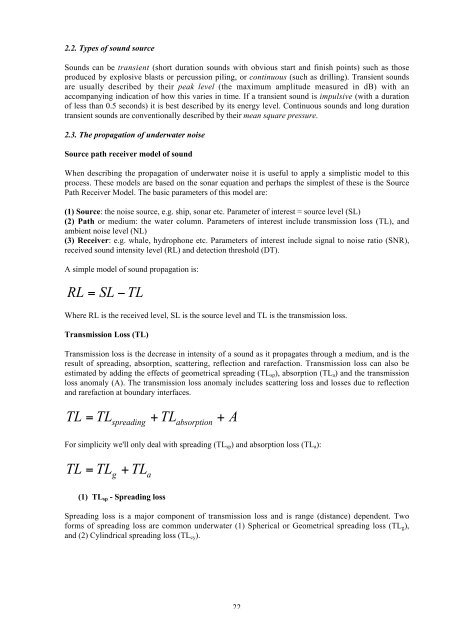Oceans of noise - Whale and Dolphin Conservation Society
Oceans of noise - Whale and Dolphin Conservation Society
Oceans of noise - Whale and Dolphin Conservation Society
You also want an ePaper? Increase the reach of your titles
YUMPU automatically turns print PDFs into web optimized ePapers that Google loves.
2.2. Types <strong>of</strong> sound source<br />
Sounds can be transient (short duration sounds with obvious start <strong>and</strong> finish points) such as those<br />
produced by explosive blasts or percussion piling, or continuous (such as drilling). Transient sounds<br />
are usually described by their peak level (the maximum amplitude measured in dB) with an<br />
accompanying indication <strong>of</strong> how this varies in time. If a transient sound is impulsive (with a duration<br />
<strong>of</strong> less than 0.5 seconds) it is best described by its energy level. Continuous sounds <strong>and</strong> long duration<br />
transient sounds are conventionally described by their mean square pressure.<br />
2.3. The propagation <strong>of</strong> underwater <strong>noise</strong><br />
Source path receiver model <strong>of</strong> sound<br />
When describing the propagation <strong>of</strong> underwater <strong>noise</strong> it is useful to apply a simplistic model to this<br />
process. These models are based on the sonar equation <strong>and</strong> perhaps the simplest <strong>of</strong> these is the Source<br />
Path Receiver Model. The basic parameters <strong>of</strong> this model are:<br />
(1) Source: the <strong>noise</strong> source, e.g. ship, sonar etc. Parameter <strong>of</strong> interest = source level (SL)<br />
(2) Path or medium: the water column. Parameters <strong>of</strong> interest include transmission loss (TL), <strong>and</strong><br />
ambient <strong>noise</strong> level (NL)<br />
(3) Receiver: e.g. whale, hydrophone etc. Parameters <strong>of</strong> interest include signal to <strong>noise</strong> ratio (SNR),<br />
received sound intensity level (RL) <strong>and</strong> detection threshold (DT).<br />
A simple model <strong>of</strong> sound propagation is:<br />
RL = SL −<br />
TL<br />
Where RL is the received level, SL is the source level <strong>and</strong> TL is the transmission loss.<br />
Transmission Loss (TL)<br />
Transmission loss is the decrease in intensity <strong>of</strong> a sound as it propagates through a medium, <strong>and</strong> is the<br />
result <strong>of</strong> spreading, absorption, scattering, reflection <strong>and</strong> rarefaction. Transmission loss can also be<br />
estimated by adding the effects <strong>of</strong> geometrical spreading (TLsp), absorption (TLa) <strong>and</strong> the transmission<br />
loss anomaly (A). The transmission loss anomaly includes scattering loss <strong>and</strong> losses due to reflection<br />
<strong>and</strong> rarefaction at boundary interfaces.<br />
TL = TLspreading<br />
+ TLabsorption<br />
+<br />
For simplicity we'll only deal with spreading (TLsp) <strong>and</strong> absorption loss (TLa):<br />
TL TL TL + =<br />
g<br />
(1) TLsp - Spreading loss<br />
a<br />
A<br />
Spreading loss is a major component <strong>of</strong> transmission loss <strong>and</strong> is range (distance) dependent. Two<br />
forms <strong>of</strong> spreading loss are common underwater (1) Spherical or Geometrical spreading loss (TLg),<br />
<strong>and</strong> (2) Cylindrical spreading loss (TLcy).<br />
22

















